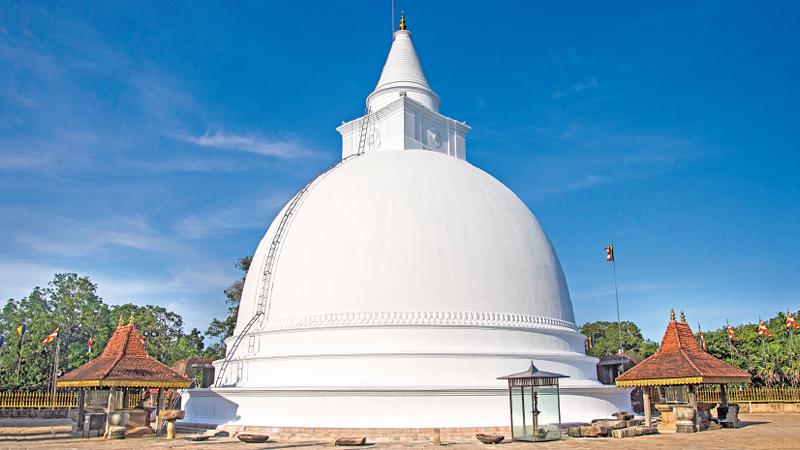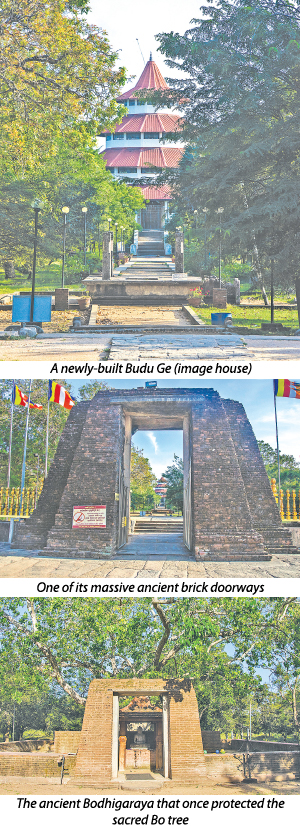
On our journey, in search of the beauty of Trincomalee, we spent another day visiting some ancient, historic Buddhist sites in Seruvila near Muttur in the Trincomalee district. We proceeded from the Somawathiya flood plain National Park, towards Seruvila, crossing the Ali Oluwa junction on the Trincomalee highway. Our destination was a unique Buddhist worshiping place, most important to Buddhists in the East, - the Seruvila Mangala Raja Maha Vihara.

 Most of the roads leading to the temple which previously had ferry points to cross the numerous waterways, now had new bridges and carpeted roads that provided greater connectivity. We were thrilled to be able to explore the many exciting sites along the way.
Most of the roads leading to the temple which previously had ferry points to cross the numerous waterways, now had new bridges and carpeted roads that provided greater connectivity. We were thrilled to be able to explore the many exciting sites along the way.
The sun was blazing, although it was evening by the time we reached Seruvila also known as Seruwavila. It is said, the name Seruvila or Seruwavila had originated from the fact that a large number of Arahat Bhikkus had visited a pond (villa), and thus the area was named sivru-vila meaning the pond the saffron robes visited. In another tale, according to the book, ‘Seeing Ceylon’ by R.L. Brohier, the Seruvila region was a vast swamp or villu where the flood waters of the Mahaweli Ganga collected. This villu was the home of large flocks of teal (seru) during migratory period. Perhaps, that was how the place came to be known as Seruvila. Its history goes back a few centuries.
A couple of pilgrims look lost in the antiquity of the temple, while an old gentleman sells booklets about the temple in the courtyard, to share his story. He told us a fascinating tale of Seruvila, considered to be one of the most revered sites as it is linked to Buddha’s third visit to Sri Lanka. Furthermore, it is said that the relics of the three Buddhas prior to Gautama Buddha, Kukusada, Konagama and Kashyapa too had been enshrined in this region. Following the Parinibbana or passing away of Gautama Buddha, the Lalata Dathu or the forehead bone relic was enshrined in the Chaitya at Seruvila, according to His wish.
Ancient legend
The significance of Seruvila Raja Maha Viharaya has not diminished with time. Even today, the temple is crowded with devotees, who brave the hot sun to pray and reflect in the spirituality of this site. The white glistering stupa with its brick-built four ancient doorways was the focal point. Devotees were seated under an ancient tree worshipping, while others placed flowers at the altar. A few yards away from the stupa was a newly built Budu Ge (shrine room) with a large seated Buddha statue. Modern paintings of Buddha’s life adorned the walls. Walking around the temple premises, we came across numerous ruins strewn across the ground. The remaining structure of the ancient Bodhigaraya that once protected the sacred Bo tree is still protectively shaded a Bo sapling.
The legend concerns King Kavantissa (209-165 BC) of Ruhuna, who left his mark here several centuries ago. The story, we are told, begins during his reign of Ruhuna which was threatened by invaders. The king had to evolve a strategy to prevent disaster. He was well aware that there was a buffer state of Seru on the north eastern seaboard of Sri Lanka, ruled by a Prince by the name of Siva. The king eventually had been able to solve the problem avoiding military confrontation and as a result he had to build a stupa at Seruvila with a complete temple complex, structures and Buddha statues which were unearthed through archaeological excavations at the site.
Having extended the king’s authority to the Seru district, King Kavantissa had caused the marsh in the vicinity of the stupa to be drained and converted into a lake. He then dedicated the lands around the shrine, an extent of eleven miles for cultivation, so the harvests could be used for the maintenance of the sacred shrine and the 500 Bhikkus who were the residents there. There is evidence of the Arahats residing in the caves around the Stupa terrace. In the vicinity of the dagoba is an ancient inscription going back to the 2nd century.
Treasure trove
We walked quietly to the site and found another inscription at the temple belonging to King Kassapa IV (898-914 AC) which mentions the Arahants and identification of the place named Tissa Maha Vehera. A group of pilgrims walk around the many panels of sculptures carved in limestone. They are strewn around, broken but glistering in the afternoon sun. These ruins too dated back to 2nd century, built by King Kavantissa and then renovated by several kings in later years.
The site is a treasure trove of antiques but the most priceless treasure belonged to King Kavantissa’s era – a magnificent Buddha statue carved in stone, with a nine-headed cobra circle found in the excavation site, has been kept for display in a museum lying a little away from the main stupa. We are told this could be the very first finding in the site to be discovered in Sri Lanka.
After the reign of King Kavantissa, this sacred site was once again restored and patronised by several kings. With the downfall of the Ruhuna and Magama kingdoms, over the years, the stupa fell into decay under pressure of North Indian Chola invasions.
Buddhists must be grateful to the erudite Bhikku, the late Ven. Mangala Dharmakirthi Sri Dambagasare Sri Sumedhankara Thera, for discovering the long forgotten Seruvila stupa in 1922. After the re-discovery, the foundation stone was laid for the stupa restoration with financial contribution from devotees forming a Seruvila Temple Development Society in 1925. In 1930, the Stupa was opened for public veneration.
The Seruvila stupa and its sacred environs covering approximately 85 acres had been declared an archaeological reserve in 1962 and the Department of Archaeology has carried out conservation work in several stages.
Due to unrest in the North and East, during the past three decades there was slow progress in the restoration work. With the war over and peace returning to the Eastern Province, now we see pilgrims throng the Seruvila temple premises. Once again, Seruvila has become a prime pilgrim location in the East.
We are joined by the pilgrims as we look at the sculptures and ancient ruined monuments strewn on temple ground. We learnt that the conservation of the stupa had been done years ago and pains taken to restore the rest and a new image house is also being built a few yards away from the main stupa. As we peer at the restored ruins and walk past the Buddha sculptures, we marvel at how a simple journey into the rustic eastern village can turn into a historic and spiritual one.
